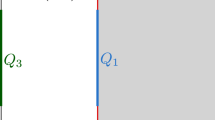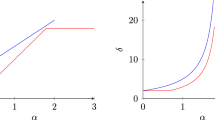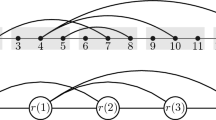Abstract
Consider a random set \(V_n \) of points in the box [n, −n)d, generated either by a Poisson process with density p or by a site percolation process with parameter p. We analyze the empirical distribution function F n of the lengths of edges in a minimal (Euclidean) spanning tree \(T_n \) on \(V_n\). We express the limit of F n, as n → ∞, in terms of the free energies of a family of percolation processes derived from \(V_n\) by declaring two points to be adjacent whenever they are closer than a prescribed distance. By exploring the singularities of such free energies, we show that the large-n limits of the moments of F n are infinitely differentiable functions of p except possibly at values belonging to a certain infinite sequence (p c(k): k ≥ 1) of critical percolation probabilities. It is believed that, in two dimensions, these limiting moments are twice differentiable at these singular values, but not thrice differentiable. This analysis provides a rigorous framework for the numerical experimentation of Dussert, Rasigni, Rasigni, Palmari, and Llebaria, who have proposed novel Monte Carlo methods for estimating the numerical values of critical percolation probabilities.
Similar content being viewed by others
REFERENCES
M. Aizenman and G. R. Grimmett, Strict monotonicity for critical points in percolation and ferromagnetic models, Journal of Statistical Physics 63:817–835 (1991).
D. Aldous and J. M. Steele, Asymptotics for Euclidean minimal spanning trees on random points, Probability Theory and Related Fields 92:247–258 (1992).
K. S. Alexander, Percolation and minimal spanning forests in infinite graphs, Annals of Probability 23:87–104 (1995).
K. S. Alexander, The RSW theorem for continuum percolation and the CLT for Euclidean spanning trees, Annals of Applied Probability 6:466–494 (1996).
J. T. Chayes, L. Chayes, and C. M. Newman, Bernoulli percolation above threshold: An invasion percolation analysis, Annals of Probability 15:1272–1287 (1987).
D. Daley and D. Vere-Jones, An Introduction to the Theory of Point Processes (Springer, New York, 1988).
A. Dolan and J. Aldous, Networks and Algorithms (Wiley, Chichester, 1993).
G. Dussert, G. Rasigni, and M. Rasigni, Minimal spanning tree approach to percolation and conductivity threshold, Physics Letters A 139:35–38 (1989).
G. Dussert, G. Rasigni, M. Rasigni, J. Palmari, and A. Llebaria, Minimal spanning tree: A new approach for studying order and disorder, Physical Review B 34:3528–3531 (1986).
W. Feller, An Introduction to Probability Theory and its Applications, Vol. 1, 3rd ed. (Wiley, New York, 1968).
G. R. Grimmett, Percolation (Springer-Verlag, Berlin, 1989).
G. R. Grimmett, Percolation and disordered systems, École d'Été de Probabilités de Saint Flour XXVI-1996 (P. Bernard, ed.), Lecture Notes in Mathematics, No. 1665, Springer, Berlin, 1997, pp. 153–300.
G. R. Grimmett and J. M. Marstrand, The supercritical phase of percolation is well behaved, Proceedings of the Royal Society (London), Series A 430:439–457 (1990).
G. R. Grimmett and D. R. Stirzaker, Probability and Random Processes, 2nd ed. (Oxford University Press, Oxford, 1992).
P. Hall, Clump counts in a mosaic, Annals of Probability 14:424–458 (1986).
C. d'Iribarne, G. Rasigni, and M. Rasigni, Determination of site percolation transitions for 2D mosaics by means of minimal spanning tree approach, Physics Letters A 209:95–98 (1995).
H. Kesten, Percolation Theory for Mathematicians (Birkhäuser, Boston, 1982).
H. Kesten and S. Lee, The central limit theorem for weighted minimal spanning trees on random points, Annals of Applied Probability 6:495–527 (1996).
J. F. C. Kingman, Poisson Processes (Oxford University Press, Oxford, 1993).
T. M. Liggett, R. H. Schonmann, and A. Stacey, Domination by product measures, Annals of Probability 25:71–95 (1997).
R. Meester and R. Roy, Continuum Percolation (Cambridge University Press, Cambridge, 1996).
M. Penrose, Continuum percolation and Euclidean minimal spanning trees in high dimensions, Annals of Applied Probability 6:528–544 (1996).
M. Penrose, The longest edge of the random minimal spanning tree, Annals of Probability 7:340–361 (1997).
L. Russo, A note on percolation, Zeitschrift für Wahrscheinlichkeitstheorie und Verwandte Gebiete 43:39–48 (1978).
J. M. Steele, Growth rates of Euclidean minimal spanning trees with power weighted edges, Annals of Probability 16:1767–1787 (1988).
Author information
Authors and Affiliations
Rights and permissions
About this article
Cite this article
Bezuidenhout, C., Grimmett, G. & Löffler, A. Percolation and Minimal Spanning Trees. Journal of Statistical Physics 92, 1–34 (1998). https://doi.org/10.1023/A:1023092317419
Issue Date:
DOI: https://doi.org/10.1023/A:1023092317419




